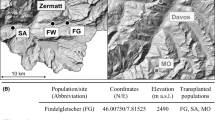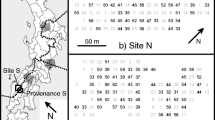Summary
A field experiment was performed to estimate the relative importance of neighbors and the rest of the environment for the growth, mortality and reproductive output of cloned individuals of the perennial bunchgrass Anthoxanthum odoratum. Single cloned Anthoxanthum tillers (targets) were reciprocally transplanted between a xeric and a mesic grassland site with one of four neighbor treatments: (1) no neighbors, (2) Anthoxanthum neighbors transplanted from the xeric site, (3) Anthoxanthum neighbors from the mesic site, and (4) Holcus lanatus neighbors. Targets without neighbors had a twofold higher two year reproductive output (RO) than those with neighbors, but there was no difference among neighbor treatments. No overall site effect on two year RO was found, because the site with the highest mortality among targets produced larger plants, with more inflorescences. Neighborhood competition was more intense at the xeric site than at the mesic site. The effects of environmental and neighborhood variation on Anthoxanthum were additive, rather than interactive. Population origin did not affect target performance significantly. Anthoxanthum neighbors of different origin did respond differentially to transplant site. There was a strong target genotype x site interaction, but no genotype x neighborhood interaction.
Similar content being viewed by others
References
Aarssen LW, Turkington R (1985) Biotic specialization between neighbouring genotypes in Lolium perenne and Trifolium repens from a permanent pasture. J Ecol 73:605–614
Allard RW, Adams J (1969) Population studies in predominantly self-pollinating species. XIII. Intergenotypic competition and population structure in barley and wheat. Am Nat 103:621–645
Antonovics J (1978) The population genetics of mixtures. In: Wilson JR (ed) Plant relations in pastures. CSIRO, East Melbourne, Australia, pp 233–252
Antonovics J, Ellstrand NC (1984) Experimental studies of the evulutionary significance of sexual reproduction. I. A test of the frequency-dependent selection hypothesis. Evolution 38:103–115
Antonovics J, Ellstrand NC, Brandon RN (1988) Genetic variation and environmental variation: expections and experiments. In: Gottlieb LD, Jain SK (eds) Plant evolutionary biology. Chapman and Hall, New York, pp 275–303
Bishop YMM, Fienberg SE, Holland PW (1975) Discrete multivariate analysis: theory and practice. MIT Press, Cambridge, Massachusetts
Brown MB (1976) Screening effects in multidimensional contingency tables. Appl Statist 25:37–46
Dixon WJ (1983) BMDP statistical software. University of California Press, Berkeley
Fienberg SE (1970) The analysis of multidimensional contingency tables. Ecology 51:419–433
Fienberg SE (1980) The analysis of cross-classified categorical data. Second edition. MIT Press, Cambridge, Massachusetts
Foin TC, Hektner MM (1986) Secondary succession and the fate of native species in a California coastal prairie community. Madrono 33:189–206
Fowler NL (1988) What is a safe site?: neighbor, litter, germination date, and patch effects. Ecology 69:947–961
Goldberg DE (1987) Neighborhood competition in an old-field plant community. Ecology 68:1211–1223
Goldberg DE (1988) Response of Solidago canadensis clones to competition. Oecologia 77:357–364
Heady HF, Foin TC, Hektner MM, Taylor DW, Barbour MG, Barry WJ (1977) Coastal prairie and northern coastal scrub In: Barbour MG, Major J (eds) Terrestrial vegetation of California. Wiley, New York, pp 733–760
Hektner MM, Foin TC (1977) Vegetation analysis of a northern California coastal prairie: Sea Ranch, Sonoma County, California. Madrono 24:83–103
Kelley SE, Clay K (1987) Interspecific competitive interactions and the maintenance of genotypic variation within two perennial grasses. Evolution 41:92–103
Lacey EP (1986) The genetic and environmental control of reproductive timing in a short-lived monocarpic species Daucus carota (Umbelliferae). J Ecol 74:73–86
Linhart YB (1988) Intrapopulation variation in annual plants. III. The contrasting effects of intra- and interspecific competition. Evolution 42:1047–1064
Martin MM, Harding J (1981) Evidence for the evolution of competition between two species of annual plants. Evolution 35:975–987
Matlack GR, Harper JL (1986) Spatial distribution and the performance of individual plants in a natural population of Silene dioica. Oecologia 70:121–127
Miller TE, Werner PA (1987) Competitive effects and responses between plant species in a first-year old-field community. Ecology 68:1201–1210
Peart DR (1989a) Species interactions in a successional grassland. I. Seed rain and seedling recruitment. J Ecol 77:236–251
Peart DR (1989b) Species interactions in a successional grassland. II. Colonization of vegetated sites. J Ecol 77:252–266
Peart DR (1989c) Species interactions in a successional grassland. III. The effects of canopy gaps, gopher mounds and grazing on colonization. J Ecol 77:267–289
Peart DR, Foin TC (1985) Analysis and prediction of population and community change: a grassaland case study. In: White J (ed) The population structure of vegetation. Handbook of Vegetation Science. Dr. W. Junk, Dordrecht, The Netherlands, pp 313–339
Platenkamp GAJ (1989) Phenotypic plasticity and genetic differentiation in the demography of the grass Anthoxanthum odoratum. PhD dissertation. University of California, Davis
SAS Institute (1985) SAS User's guide: statistics. SAS Institute, Cary, North Carolina
Schlichting CD, Levin DA (1984) Phenotypic plasticity of annual phlox: tests of some hypotheses. Am J Bot 71:252–260
Sultan SE (1987) Evolutionary implications of phenotypic plasticity in plants. Evol Biol 21:127–178
Turkington R (1979) Neighbour relationships in grass-legume communities. IV. Fine scale biotic differentiation. Can J Bot 57:2711–2716
Turkington R, Aarssen LW (1984) Local scale differentiation as a result of competitive interactions. In: Dirzo R, Sarukhan J (eds) Perspectives on plant population ecology. Sinauer, Sunderland, Massachusetts, pp 107–127
Turkington R, Harper JL (1979) The growth, distribution and neighbour relations of Trifolium repens in a permanent pasture. IV. Fine-scale biotic differentiation. J Ecol 67:245–254
Via S (1984) The quantitative genetics of polyphagy in an insect herbivore. I. Genotype-environment interaction in larval performance on different host plant species. Evolution 38:881–895
Waller DM (1981) Neighborhood competition in several violet populations. Oecologia 51:116–122
Watkinson AR, Harper JL (1978) The demography of a sand dune annual Vulpia fasciculata: I. The natural regulation of populations. J Ecol 66:15–33
Weiner J (1984) Neighborhood interference amongst Pinus rigida individuals. J Ecol 72:183–195
Welden CW, Slauson WL (1986) The intensity of competition versus its importance: an overlooked distinction and some implications. Quart Rev Biol 61:23–44
Welsch RE (1977) Stepwise multiple comparison procedures. J Amer Statist Assoc 72:566–575
Wu L, Jain S (1980) Self-fertility and seed set in natural populations of Anthoxanthum odoratum L. Bot Gaz 141:300–304
Zar JH (1974) Biostatistical analysis. Prentice-Hall, Englewood Cliffs, New Jersey
Author information
Authors and Affiliations
Rights and permissions
About this article
Cite this article
Platenkamp, G.A.J., Foin, T.C. Ecological and evolutionary importance of neighbors in the grass Anthoxanthum odoratum . Oecologia 83, 201–208 (1990). https://doi.org/10.1007/BF00317753
Received:
Accepted:
Issue Date:
DOI: https://doi.org/10.1007/BF00317753




